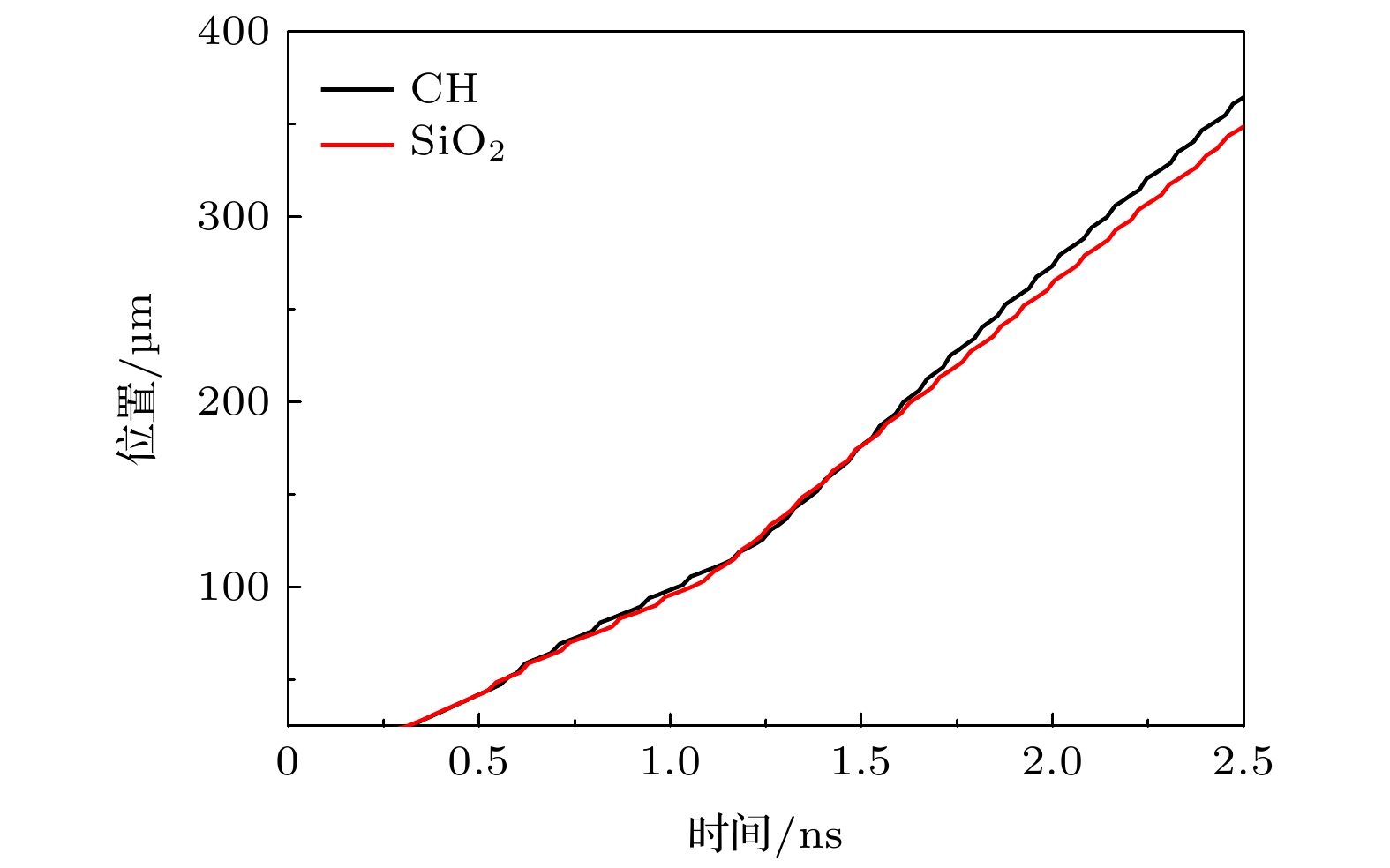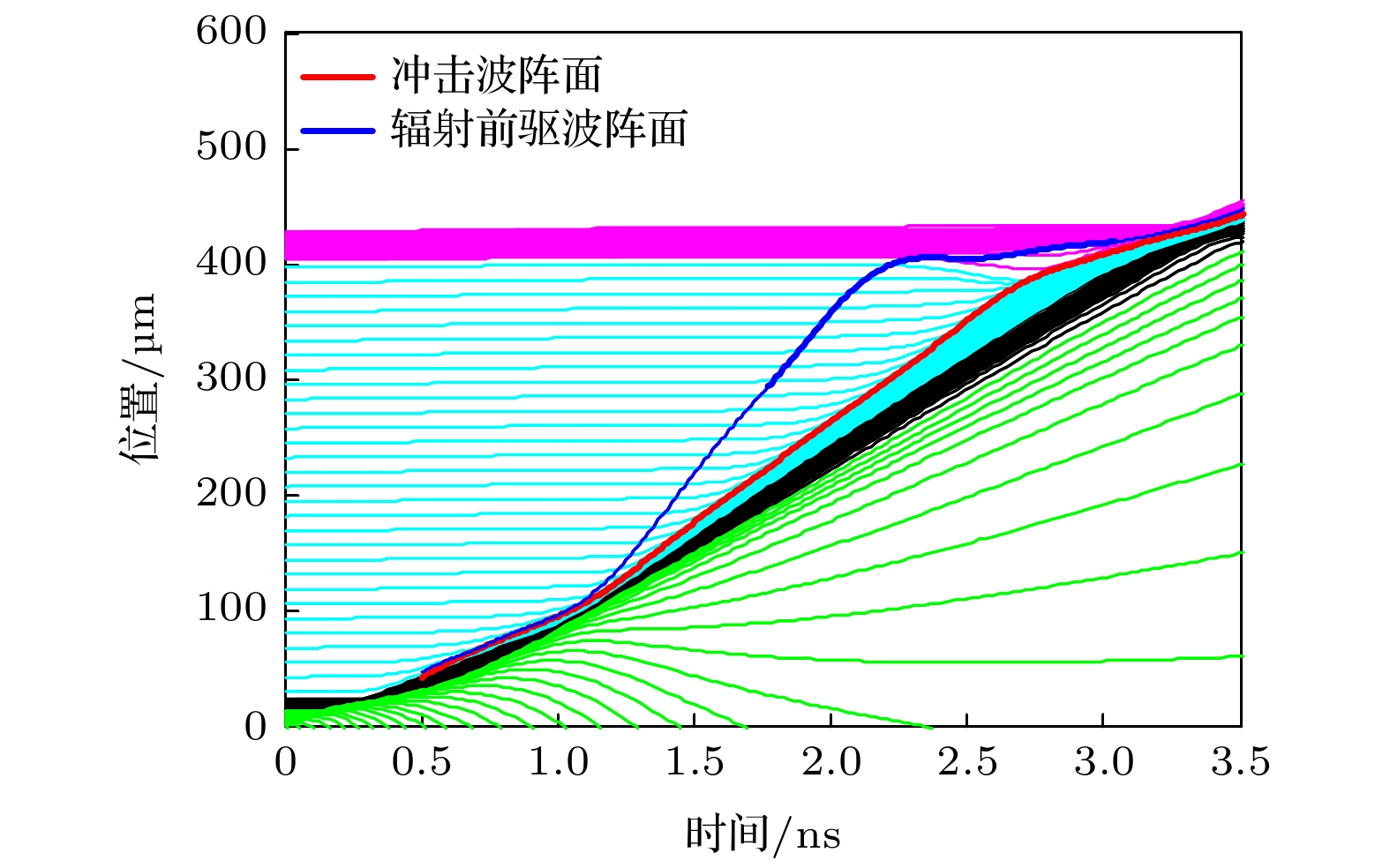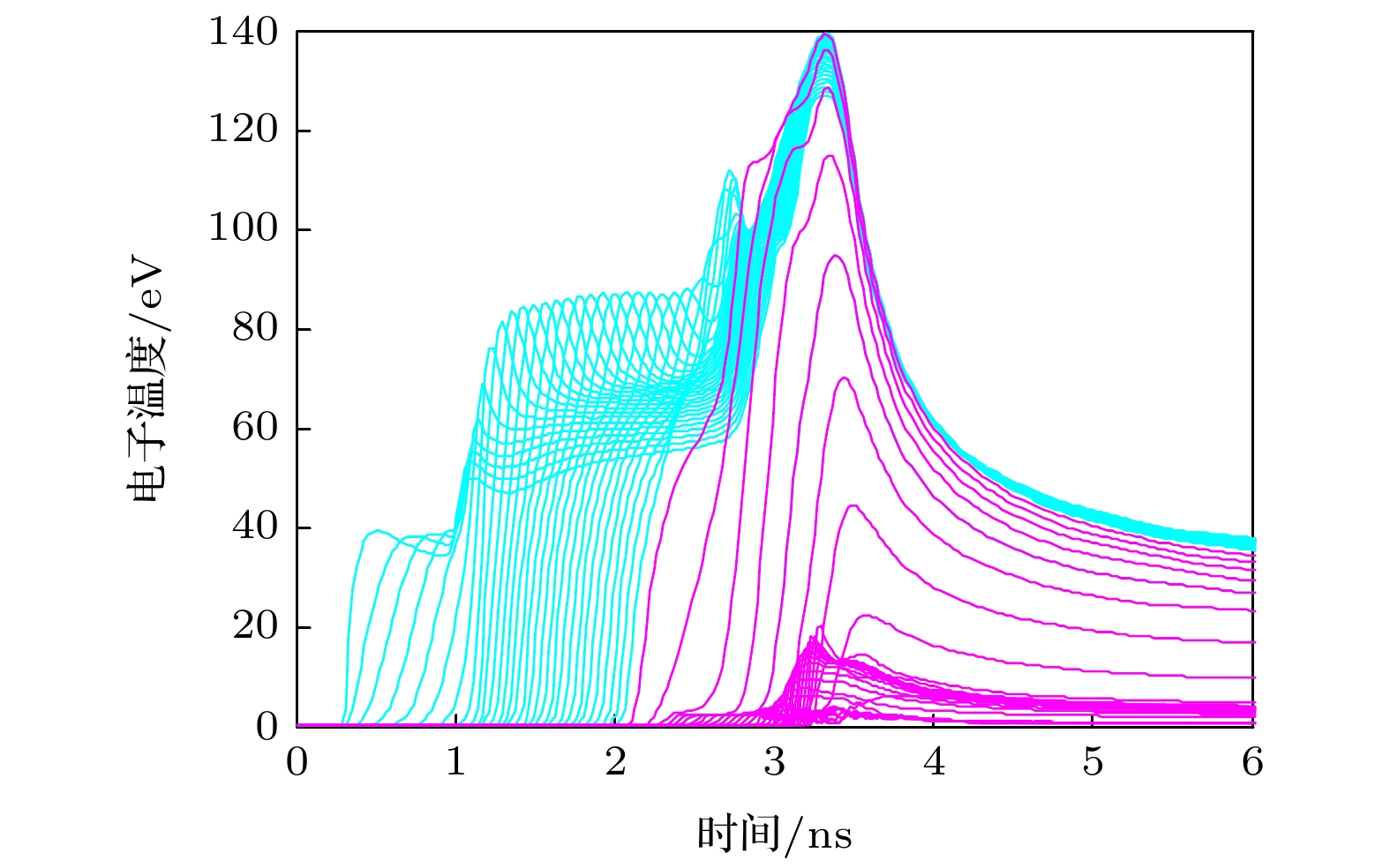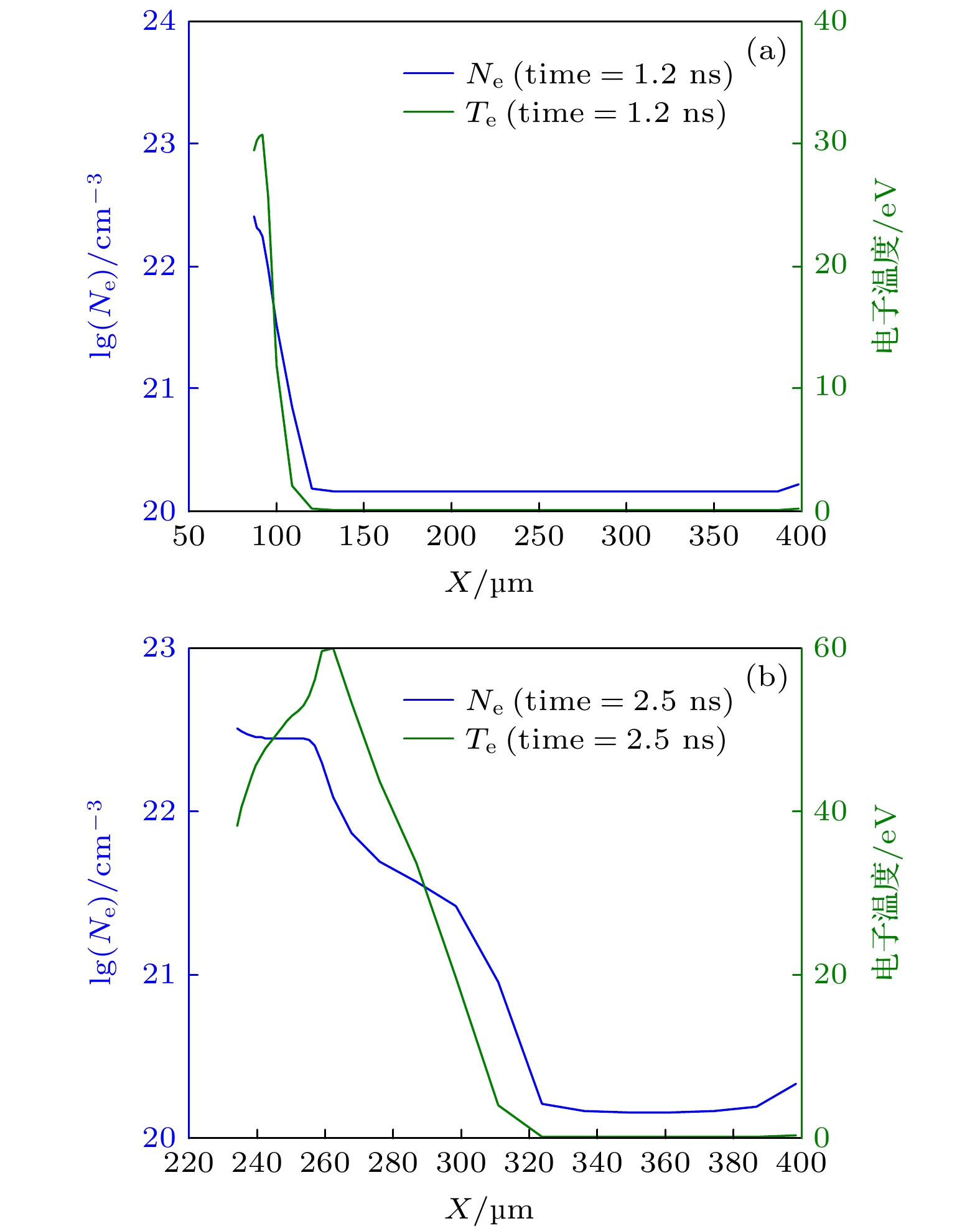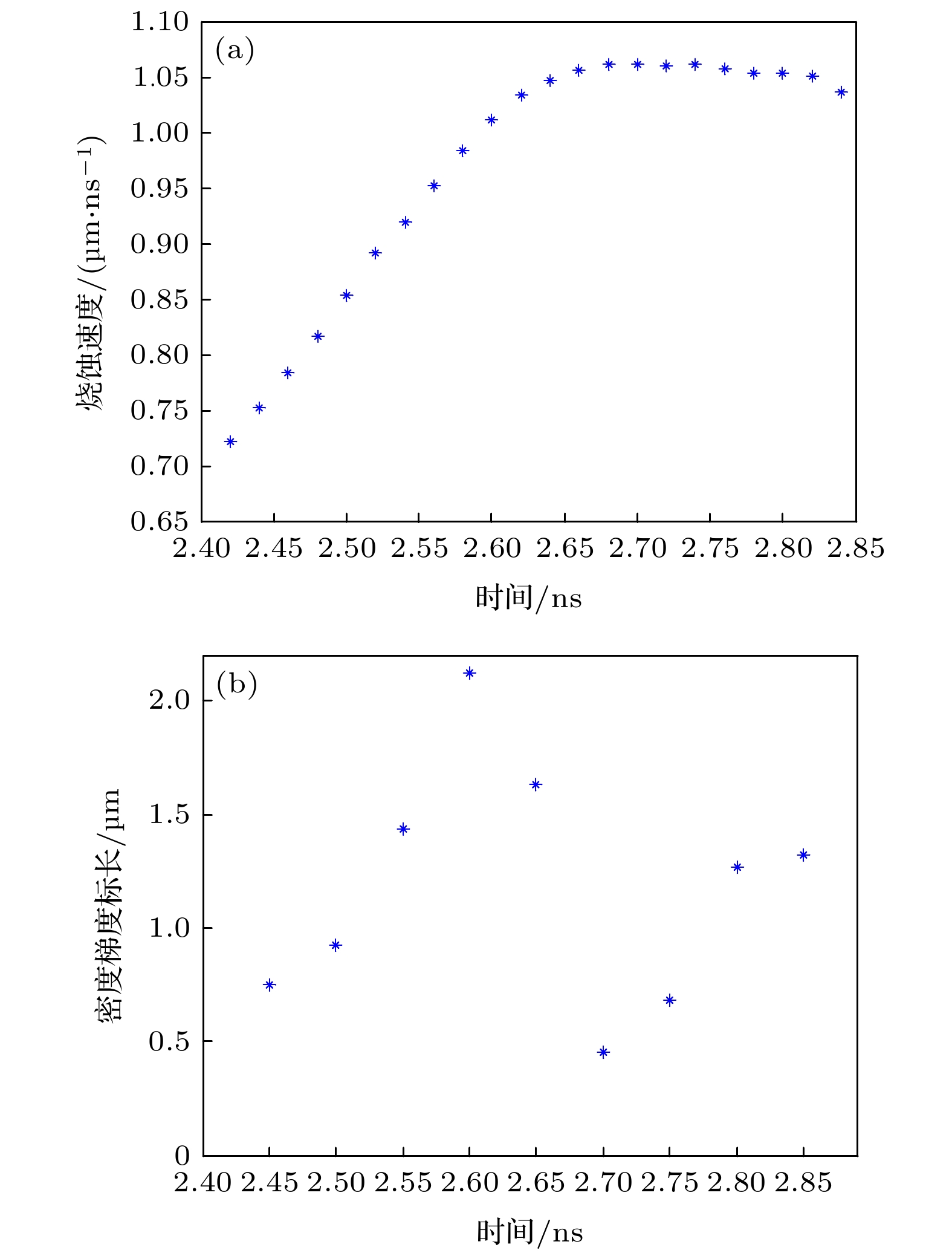-
Radiative shocks are ubiquitous in stellar environments and are characterized by high temperature plasma emitting a considerable fraction of their energy as radiation. Radiative shocks occur commonly in nature, especially in astronomical systems and inertial confinement fusion. The study of the effects of radiation on Richtmyer-Meshkov (RM) instability will improve our ability to understand and predict the evolution of RM instability under high energy density conditions. A few experiments have been performed to compare the radiative case with the non-radiative case in Rayleigh-Taylor (RT) instability, thereby studying how the radiative effects change the evolution of RT instability, but the interplay between RM instability and radiative shock has been studied rarely. This paper reports mainly the role of radiation in the changing of the RM instability. Two experiments are performed at Shenguang III prototype laser facility, the RM instability growth data are obtained by varying the laser intensity. The laser intensity for high-drive experiment is approximately 60% greater than that for low-drive experiment. The target consists of a multiple layer in the axial direction, in which the first layer is a 15μm-thick CH sample serving as an ablator, followed by a 10 μm-thick aluminum used as a shield layer to prevent the preheat effect. The next layer is a 350-μm-thick SiO2 foam, which is used as a material to produce a radiative shock. The last layer is the CH perturbed sample. There is a sinusoidal perturbation on the surface of CH sample which is adjacent to the SiO2 foam. The target is irradiated by four overlapping laser beams, and the laser beams produce a large pressure that drives a shock wave, whose velocity can be changed by varying the laser intensity, into the target package. In the experiments, shock-generated radiative fluxes first ablate the unstable interface which the shock has not passed through, then the shock transmits the unstable interface to produce the RM instability. The images of unstable interface are captured using side-on x-ray radiography, and the experimental results show that the RM growth is suppressed in the experiment for the higher laser intensity. Radiation hydrodynamic code Multi1D is used to evaluate the electron temperature, shock velocity, and electron density. The simulations show that the foam temperature in the high-drive case can reach 80 eV in the front of shock, this energy flows away from the shock front, generating a radiative precursor ahead of the shock. The radiative precursor velocity of 270 km/s is much larger than the shock velocity of 170 km/s, the radiative precursor arrives at the unstable interface before the shock and ablates the unstable interface, so the radiative flux changes the initial conditions of unstable interface. When the shock propagates through the unstable interface, the ablation increases the density gradient length scale and reduces the Atwood number of the unstable interface, so the RM growth is suppressed in the high-drive case because of the ablation of the radiative precursor. -
Keywords:
- radiative shock /
- Richtmyer-Meshkov instability /
- density-gradient scale /
- ablation velocity /
- Atwood number
[1] Remington B A, Drake R P, Takabe H, Arnett D 2000 Phys. Plasmas 7 1641
 Google Scholar
Google Scholar
[2] Remington B A, Drake R P, Ryntov D D 2006 Rev. Mod. Phys. 78 755
 Google Scholar
Google Scholar
[3] Kuranz C C, Park H S, Remington B A, et al. 2011 Astrophys. Space Sci. 336 207
 Google Scholar
Google Scholar
[4] Trantham M R, Kuranz C C, Malamud G, et al. 2013 High Energy Density Phys. 9 303
 Google Scholar
Google Scholar
[5] Flaig M, Plewa T, Keiter P A, Drake R P, Grosskopf M, Kuranz C, Park H S 2014 High Energy Density Phys. 12 35
 Google Scholar
Google Scholar
[6] Li J W, Pei W B, He X T, Li J H, Zheng W D, Zhu S P, Kang W 2013 Phys. Plasmas 20 082707
 Google Scholar
Google Scholar
[7] Pak A, Divol L, Gregori G, et al. 2013 Phys. Plasmas 20 056315
 Google Scholar
Google Scholar
[8] Reighard A B, Drake R P, Dannenberg K K, et al. 2006 Phys. Plasmas 13 082901
 Google Scholar
Google Scholar
[9] Stehlé C, González M, Kozlva M, et al. 2010 Laser Part. Beams 28 253
 Google Scholar
Google Scholar
[10] Kuranz C C, Drake R P, Huntington C M, et al. 2013 High Energy Density Phys. 9 315
 Google Scholar
Google Scholar
[11] Michaut C, Vinci T, Boireau L, et al. 2007 Astrophys. Space Sci. 307 159
 Google Scholar
Google Scholar
[12] Chaulagain U, Stehlé C, Larour J, et al. 2015 High Energy Density Phys. 17 106
 Google Scholar
Google Scholar
[13] Cotelo M, Velarde P, Varga A G, Portillo D, Stehlé C, Chaulagain U, Kozlova M, Larour J, Suzuki-Vidal F 2015 High Energy Density Phys. 17 68
 Google Scholar
Google Scholar
[14] Vinci T, Koenig M, Benuzzi-Mounaix A, Michaut C, Boireau L, Leygnac S, Bouquet S, Peyrusse O, Batani D 2006 Phys. Plasmas 13 010702
 Google Scholar
Google Scholar
[15] Michel T, Albertazzi B, Mabey P, Rigon G, Lefevre F, Som L, Barroso P, Egashira S, Kumar R, Michaut C, Ota M, Ozaki N, Sakawa Y, Sano T, Falize E, Koenig M 2020 Astrophys. J. 25 888
[16] Keiter P A, Drake R P, Perry T S, Robey H F, Remington B A, Iglesias C A, Wallace R J 2002 Phys. Rev. Lett. 89 165003
 Google Scholar
Google Scholar
[17] Nilsen J, Kritcher A L, Martin M E, Tipton R E, Whitley H D, Swift D C, Döppner T, Bachmann B L, Lazicki A E, Kostinski N B, Maddox B R, Collins G W, Glenzer S H, Falcone R W 2020 Matter Radiat. Extremes 5 018401
 Google Scholar
Google Scholar
[18] Huntington C M, Shimony A, Trantham M, et al. 2018 Phys. Plasmas 25 052118
 Google Scholar
Google Scholar
[19] Kuranz C C, Park H S, Huntington C M, et al. 2018 Nat. Commun. 9 1564
 Google Scholar
Google Scholar
[20] 庄礼贤, 尹协远, 马晖扬 2009 流体力学(合肥: 中国科学技术大学出版社) 第268页
Zhuang L X, Yin X Y, Ma H Y 2009 Fluid Mechanics (Hefei: University of Science and Technology of China Press) p268 (in Chinese)
[21] Motl B J 2008 Ph. D. Dissertation (Wisconsin: University of Wisconsin- Madison)
[22] Dimonte G, Frerking C E, Schneider M, Remington B 1995 Phys. Plasmas 3 614
[23] 张璐, 杨家敏 2012 物理学报 61 045203
 Google Scholar
Google Scholar
Zhang L, Yang J M 2012 Acta Phys. Sin. 61 045203
 Google Scholar
Google Scholar
[24] Martinez D A, Smalyuk V A, MacPhee A G, et al. 2017 Phys. Plasmas 24 102707
 Google Scholar
Google Scholar
[25] 肖德龙, 孙顺凯, 薛创, 张扬, 丁宁 2015 物理学报 64 235203
 Google Scholar
Google Scholar
Xiao D L, Sun S K, Xue C, Zhang Y, Ding L 2015 Acta Phys. Sin. 64 235203
 Google Scholar
Google Scholar
[26] 蒙世坚, 黄展常, 甯家敏, 胡青元, 叶繁, 秦义, 许泽平, 徐荣昆 2016 物理学报 65 075201
 Google Scholar
Google Scholar
Meng S J, Huang Z C, Ning J M, Hu Q Y, Ye F, Qin Y, Xu Z P, Xu R K 2016 Acta Phys. Sin. 65 075201
 Google Scholar
Google Scholar
-
表 1 激光功率密度1 × 1015 W/cm2条件下激光参数统计
Table 1. Laser parameters at a laser intensity of 1 × 1015 W/cm2.
发次号 记录图像
时刻/ns设计能
量/J实际输出
能量/J实际输出能量与
设计能量偏差/%057 5 2000 1931 –3.45 056 6 2000 1983 –0.85 054 8 2000 1988 –0.60 表 2 激光功率密度1.6 × 1015 W/cm2条件下激光参数统计
Table 2. Laser parameters at a laser intensity of 1.6 × 1015 W/cm2.
发次号 记录图像
时刻/ns设计能
量/J实际输出
能量/J实际输出能量与
设计能量偏差/%061 5 3200 3080 –3.75 055 8 3200 2812 –12.1 -
[1] Remington B A, Drake R P, Takabe H, Arnett D 2000 Phys. Plasmas 7 1641
 Google Scholar
Google Scholar
[2] Remington B A, Drake R P, Ryntov D D 2006 Rev. Mod. Phys. 78 755
 Google Scholar
Google Scholar
[3] Kuranz C C, Park H S, Remington B A, et al. 2011 Astrophys. Space Sci. 336 207
 Google Scholar
Google Scholar
[4] Trantham M R, Kuranz C C, Malamud G, et al. 2013 High Energy Density Phys. 9 303
 Google Scholar
Google Scholar
[5] Flaig M, Plewa T, Keiter P A, Drake R P, Grosskopf M, Kuranz C, Park H S 2014 High Energy Density Phys. 12 35
 Google Scholar
Google Scholar
[6] Li J W, Pei W B, He X T, Li J H, Zheng W D, Zhu S P, Kang W 2013 Phys. Plasmas 20 082707
 Google Scholar
Google Scholar
[7] Pak A, Divol L, Gregori G, et al. 2013 Phys. Plasmas 20 056315
 Google Scholar
Google Scholar
[8] Reighard A B, Drake R P, Dannenberg K K, et al. 2006 Phys. Plasmas 13 082901
 Google Scholar
Google Scholar
[9] Stehlé C, González M, Kozlva M, et al. 2010 Laser Part. Beams 28 253
 Google Scholar
Google Scholar
[10] Kuranz C C, Drake R P, Huntington C M, et al. 2013 High Energy Density Phys. 9 315
 Google Scholar
Google Scholar
[11] Michaut C, Vinci T, Boireau L, et al. 2007 Astrophys. Space Sci. 307 159
 Google Scholar
Google Scholar
[12] Chaulagain U, Stehlé C, Larour J, et al. 2015 High Energy Density Phys. 17 106
 Google Scholar
Google Scholar
[13] Cotelo M, Velarde P, Varga A G, Portillo D, Stehlé C, Chaulagain U, Kozlova M, Larour J, Suzuki-Vidal F 2015 High Energy Density Phys. 17 68
 Google Scholar
Google Scholar
[14] Vinci T, Koenig M, Benuzzi-Mounaix A, Michaut C, Boireau L, Leygnac S, Bouquet S, Peyrusse O, Batani D 2006 Phys. Plasmas 13 010702
 Google Scholar
Google Scholar
[15] Michel T, Albertazzi B, Mabey P, Rigon G, Lefevre F, Som L, Barroso P, Egashira S, Kumar R, Michaut C, Ota M, Ozaki N, Sakawa Y, Sano T, Falize E, Koenig M 2020 Astrophys. J. 25 888
[16] Keiter P A, Drake R P, Perry T S, Robey H F, Remington B A, Iglesias C A, Wallace R J 2002 Phys. Rev. Lett. 89 165003
 Google Scholar
Google Scholar
[17] Nilsen J, Kritcher A L, Martin M E, Tipton R E, Whitley H D, Swift D C, Döppner T, Bachmann B L, Lazicki A E, Kostinski N B, Maddox B R, Collins G W, Glenzer S H, Falcone R W 2020 Matter Radiat. Extremes 5 018401
 Google Scholar
Google Scholar
[18] Huntington C M, Shimony A, Trantham M, et al. 2018 Phys. Plasmas 25 052118
 Google Scholar
Google Scholar
[19] Kuranz C C, Park H S, Huntington C M, et al. 2018 Nat. Commun. 9 1564
 Google Scholar
Google Scholar
[20] 庄礼贤, 尹协远, 马晖扬 2009 流体力学(合肥: 中国科学技术大学出版社) 第268页
Zhuang L X, Yin X Y, Ma H Y 2009 Fluid Mechanics (Hefei: University of Science and Technology of China Press) p268 (in Chinese)
[21] Motl B J 2008 Ph. D. Dissertation (Wisconsin: University of Wisconsin- Madison)
[22] Dimonte G, Frerking C E, Schneider M, Remington B 1995 Phys. Plasmas 3 614
[23] 张璐, 杨家敏 2012 物理学报 61 045203
 Google Scholar
Google Scholar
Zhang L, Yang J M 2012 Acta Phys. Sin. 61 045203
 Google Scholar
Google Scholar
[24] Martinez D A, Smalyuk V A, MacPhee A G, et al. 2017 Phys. Plasmas 24 102707
 Google Scholar
Google Scholar
[25] 肖德龙, 孙顺凯, 薛创, 张扬, 丁宁 2015 物理学报 64 235203
 Google Scholar
Google Scholar
Xiao D L, Sun S K, Xue C, Zhang Y, Ding L 2015 Acta Phys. Sin. 64 235203
 Google Scholar
Google Scholar
[26] 蒙世坚, 黄展常, 甯家敏, 胡青元, 叶繁, 秦义, 许泽平, 徐荣昆 2016 物理学报 65 075201
 Google Scholar
Google Scholar
Meng S J, Huang Z C, Ning J M, Hu Q Y, Ye F, Qin Y, Xu Z P, Xu R K 2016 Acta Phys. Sin. 65 075201
 Google Scholar
Google Scholar
Catalog
Metrics
- Abstract views: 2909
- PDF Downloads: 56
- Cited By: 0















 DownLoad:
DownLoad:
